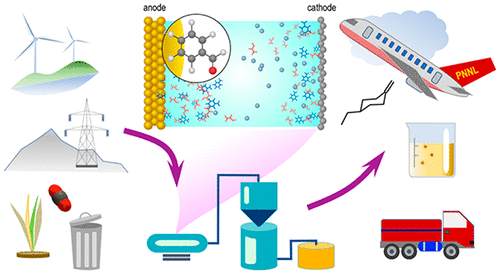当前位置:
X-MOL 学术
›
Chem. Rev.
›
论文详情
Our official English website, www.x-mol.net, welcomes your
feedback! (Note: you will need to create a separate account there.)
Electrocatalytic Hydrogenation of Biomass-Derived Organics: A Review.
Chemical Reviews ( IF 51.4 ) Pub Date : 2020-09-17 , DOI: 10.1021/acs.chemrev.0c00158 Sneha A Akhade 1, 2 , Nirala Singh 1, 3 , Oliver Y Gutiérrez 1 , Juan Lopez-Ruiz 1 , Huamin Wang 1 , Jamie D Holladay 4 , Yue Liu 4 , Abhijeet Karkamkar 1 , Robert S Weber 1 , Asanga B Padmaperuma 1 , Mal-Soon Lee 1 , Greg A Whyatt 1 , Michael Elliott 1 , Johnathan E Holladay 1 , Jonathan L Male 1 , Johannes A Lercher 1, 4 , Roger Rousseau 1 , Vassiliki-Alexandra Glezakou 1
Chemical Reviews ( IF 51.4 ) Pub Date : 2020-09-17 , DOI: 10.1021/acs.chemrev.0c00158 Sneha A Akhade 1, 2 , Nirala Singh 1, 3 , Oliver Y Gutiérrez 1 , Juan Lopez-Ruiz 1 , Huamin Wang 1 , Jamie D Holladay 4 , Yue Liu 4 , Abhijeet Karkamkar 1 , Robert S Weber 1 , Asanga B Padmaperuma 1 , Mal-Soon Lee 1 , Greg A Whyatt 1 , Michael Elliott 1 , Johnathan E Holladay 1 , Jonathan L Male 1 , Johannes A Lercher 1, 4 , Roger Rousseau 1 , Vassiliki-Alexandra Glezakou 1
Affiliation

|
Sustainable energy generation calls for a shift away from centralized, high-temperature, energy-intensive processes to decentralized, low-temperature conversions that can be powered by electricity produced from renewable sources. Electrocatalytic conversion of biomass-derived feedstocks would allow carbon recycling of distributed, energy-poor resources in the absence of sinks and sources of high-grade heat. Selective, efficient electrocatalysts that operate at low temperatures are needed for electrocatalytic hydrogenation (ECH) to upgrade the feedstocks. For effective generation of energy-dense chemicals and fuels, two design criteria must be met: (i) a high H:C ratio via ECH to allow for high-quality fuels and blends and (ii) a lower O:C ratio in the target molecules via electrochemical decarboxylation/deoxygenation to improve the stability of fuels and chemicals. The goal of this review is to determine whether the following questions have been sufficiently answered in the open literature, and if not, what additional information is required:
中文翻译:

生物质衍生有机物的电催化加氢:综述。
可持续能源生产要求从集中式、高温、能源密集型过程转变为可由可再生能源产生的电力驱动的分散式低温转换。在没有汇和高品位热源的情况下,生物质衍生原料的电催化转化将允许分布式能源贫乏资源的碳循环。电催化加氢 (ECH) 需要在低温下运行的选择性、高效的电催化剂来升级原料。为了有效地生产高能量的化学品和燃料,必须满足两个设计标准:(i) 通过 ECH 实现高 H:C 比以允许高质量的燃料和混合物,以及 (ii) 较低的 O:通过电化学脱羧/脱氧来提高目标分子中的 C 比率,以提高燃料和化学品的稳定性。本综述的目的是确定以下问题是否已在公开文献中得到充分回答,如果没有,还需要哪些额外信息:
更新日期:2020-10-29
| (1) | What organic functionalities are accessible for electrocatalytic hydrogenation under a set of reaction conditions? How do substitutions and functionalities impact the activity and selectivity of ECH? | ||||
| (2) | What material properties cause an electrocatalyst to be active for ECH? Can general trends in ECH be formulated based on the type of electrocatalyst? | ||||
| (3) | What are the impacts of reaction conditions (electrolyte concentration, pH, operating potential) and reactor types? | ||||
中文翻译:

生物质衍生有机物的电催化加氢:综述。
可持续能源生产要求从集中式、高温、能源密集型过程转变为可由可再生能源产生的电力驱动的分散式低温转换。在没有汇和高品位热源的情况下,生物质衍生原料的电催化转化将允许分布式能源贫乏资源的碳循环。电催化加氢 (ECH) 需要在低温下运行的选择性、高效的电催化剂来升级原料。为了有效地生产高能量的化学品和燃料,必须满足两个设计标准:(i) 通过 ECH 实现高 H:C 比以允许高质量的燃料和混合物,以及 (ii) 较低的 O:通过电化学脱羧/脱氧来提高目标分子中的 C 比率,以提高燃料和化学品的稳定性。本综述的目的是确定以下问题是否已在公开文献中得到充分回答,如果没有,还需要哪些额外信息:
| (1) | 在一组反应条件下,哪些有机官能团可用于电催化氢化?取代和功能如何影响 ECH 的活性和选择性? | ||||
| (2) | 什么材料特性导致电催化剂对 ECH 具有活性?能否根据电催化剂的类型制定 ECH 的总体趋势? | ||||
| (3) | 反应条件(电解质浓度、pH 值、操作电位)和反应器类型有何影响? | ||||











































 京公网安备 11010802027423号
京公网安备 11010802027423号